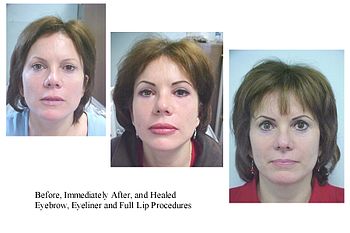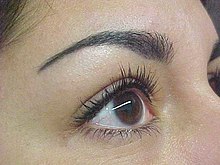
A tattoo is a form of body modification made by inserting tattoo ink, dyes, and/or pigments, either indelible or temporary, into the dermis layer of the skin to form a design. Tattoo artists create these designs using several tattooing processes and techniques, including hand-tapped traditional tattoos and modern tattoo machines. The history of tattooing goes back to Neolithic times, practiced across the globe by many cultures, and the symbolism and impact of tattoos varies in different places and cultures.

Cosmetics are composed of mixtures of chemical compounds derived from either natural sources or synthetically created ones. Cosmetics have various purposes. Those designed for personal care and skin care can be used to cleanse or protect the body and skin. Cosmetics designed to enhance or alter one's appearance (makeup) can be used to conceal blemishes, enhance one's natural features, add color to a person's face, or change the appearance of the face entirely to resemble a different person, creature or object. Cosmetics can also be designed to add fragrance to the body.
Intense pulsed light (IPL) is a technology used by cosmetic and medical practitioners to perform various skin treatments for aesthetic and therapeutic purposes, including hair removal, photorejuvenation as well as to alleviate dermatologic diseases such as acne. IPL is increasingly used in optometry and ophthalmology as well, to treat evaporative dry eye disease due to meibomian gland dysfunction.

An eyebrow is an area of short hairs above each eye that follows the shape of the lower margin of the brow ridges of some mammals. In humans, eyebrows serve two main functions: first, communication through facial expression, and second, prevention of sweat, water, and other debris from falling down into the eye socket. It is common for people to modify their eyebrows by means of hair removal and makeup.

Cosmetology is the study and application of beauty treatment. Branches of specialty include hairstyling, skin care, cosmetics, manicures/pedicures, non-permanent hair removal such as waxing and sugaring, and permanent hair removal processes such as electrology and intense pulsed light (IPL).

A medical tattoo is a tattoo used to treat a condition, communicate medical information, or mark a body location for treatment. People may get a paramedical tattoo to conceal a condition or the effects of treatment, such as creating the appearance of an areola after breast reconstruction, or a cover-up tattoo to disguise the area in an artistic way.

Body painting is a form of body art where artwork is painted directly onto the human skin. Unlike tattoos and other forms of body art, body painting is temporary, lasting several hours or sometimes up to a few weeks. Body painting that is limited to the face is known as face painting. Body painting is also referred to as "temporary tattoo". Large scale or full-body painting is more commonly referred to as body painting, while smaller or more detailed work can sometimes be referred to as temporary tattoos.

A concealer or color corrector is a type of cosmetic that is used to mask imperfections on the skin. These imperfections can include dark circles under the eyes, blemishes, and hyperpigmentation. Concealer is similar to, and can be used in conjunction with foundation, a lighter cosmetic that is used to even out the skin tone. Both concealer and foundation are typically used to make skin appear smoother and more uniform in color. These two types of cosmetics differ in that concealers tend to be more heavily pigmented, though concealer and foundation are both available in a wide range of colors and opacities.
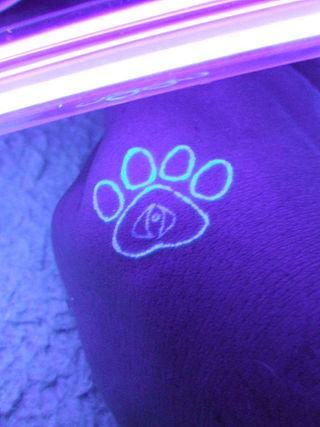
UV tattoos or blacklight tattoos are tattoos made with dyes that fluoresce visibly under a blacklight or other ultraviolet (UV) light source. Depending upon the tattoo ink used, an ultraviolet tattoo can be nearly invisible when illuminated only by light within the visible spectrum. Blacklight tattoo ink does not glow in the dark, but reacts to non-visible ultraviolet light, producing a visible glow by fluorescence.
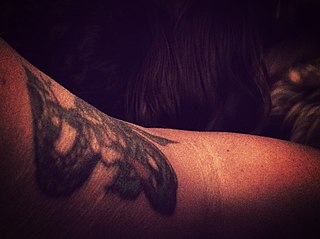
Tattoo removal is the process of removing an unwanted tattoo. The process of tattooing generally creates permanent markings in the skin, but people have attempted many methods to try to hide or destroy tattoos.
Cosmetic camouflage is the application of make-up creams and/or powders to conceal colour or contour irregularities or abnormalities of the face or body. It offers an answer to solve all related skin problems such as Congenital origin, Traumatic origin and Dermatological origin. Furthermore, cosmetic camouflage solves the psychological problems that a skin imperfection is sometimes able to provoke, it allows to rediscover its own beauty and to return with serenity to its own social life. Cosmetic camouflage creams were first developed by plastic surgeons during World War II to cover the massive burns received by fighter pilots. Nowadays, men, women and children can use cosmetic camouflage.
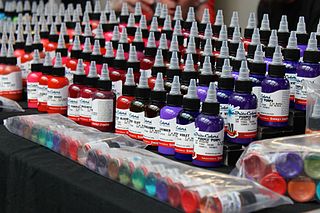
Tattoo inks consist of pigments combined with a carrier, used in the process of tattooing to create a tattoo in the skin. These inks are also used for permanent makeup, a form of tattoo.

Airbrush makeup is makeup sprayed onto the skin using an airbrush machine instead of being applied with sponges, brushes, fingers, or other methods. A typical airbrush system uses a compressor to create airflow through a hose connected to a trigger-controlled spray painting gun. The airbrush pressure can be adjusted to apply various types of makeup, such as lighter, heavier, or more detailed styles. Airbrushes are used in film, theater, bridal makeup, and sunless tanning. Airbrush systems designed for personal, in-home use are usually smaller and work at a lower pressure than systems used in professional applications.
A variety of health effects can result from tattooing. Because it requires breaking the skin barrier, tattooing carries inherent health risks, including infection and allergic reactions. Modern tattooists reduce such risks by following universal precautions, working with single-use disposable needles, and sterilising equipment after each use. Many jurisdictions require tattooists to undergo periodic bloodborne pathogen training, such as is provided through the Red Cross and the U.S. Occupational Safety and Health Administration.

Mary Jane Haake is an American tattoo artist and authority on medical tattooing and permanent makeup. She was instrumental in bringing topical anesthetics to the tattooing and body modification industries.

Ingenol mebutate, sold under the brand name Picato, is a substance that is found in the sap of the plant Euphorbia peplus, commonly known as petty spurge, and is an inducer of cell death. This compound was isolated first from this plant in 2000. A gel formulation of the drug has been approved by the U.S. Food and Drug Administration (FDA) and by the European Medicines Agency (EMA) for the topical treatment of actinic keratosis. Two different strengths of the gel have been approved for use on either the face and scalp (0.015%) or the trunk and extremities (0.05%), respectively. In 2020 the drug was withdrawn from the market in the EU.

The process or technique of tattooing, creating a tattoo, involves the insertion of pigment into the skin's dermis. Traditionally, tattooing often involved rubbing pigment into cuts. Modern tattooing almost always requires the use of a tattoo machine and often procedures and accessories to reduce the risk to human health.
Microblading is a tattooing technique which uses a small handheld tool made of several tiny needles to add semi-permanent pigment to the skin. Microblading differs from standard eyebrow tattooing, a form of permanent makeup, as each hair stroke is created by hand with a blade that creates fine slices in the skin, whereas eyebrow tattoos are done with a tattoo machine. Microblading is used on eyebrows to create, enhance, or alter their appearance in shape and color. It deposits pigment into the upper region of the dermis, so it fades more rapidly than traditional tattooing techniques. Microblading is often referred to as eyebrow embroidery, eyebrow feathering, microstroking, 3D eyebrows, nanoblading or hair-like strokes.
Tattooing in South Korea has a long and controversial history. South Korean law permits only licensed medical practitioners, as opposed to tattoo artists without medical degrees, to open tattoo parlors, although it is not illegal to have a tattoo. Only the army prohibits tattoos. People can have tattoos after serving in the military. Attitudes towards tattoos and people who have them are often negative, particularly among the older generations of South Koreans.
Male grooming refers to men paying attention to fashion and enhancing their own appearance. This interest has become increasingly apparent in popular culture.
